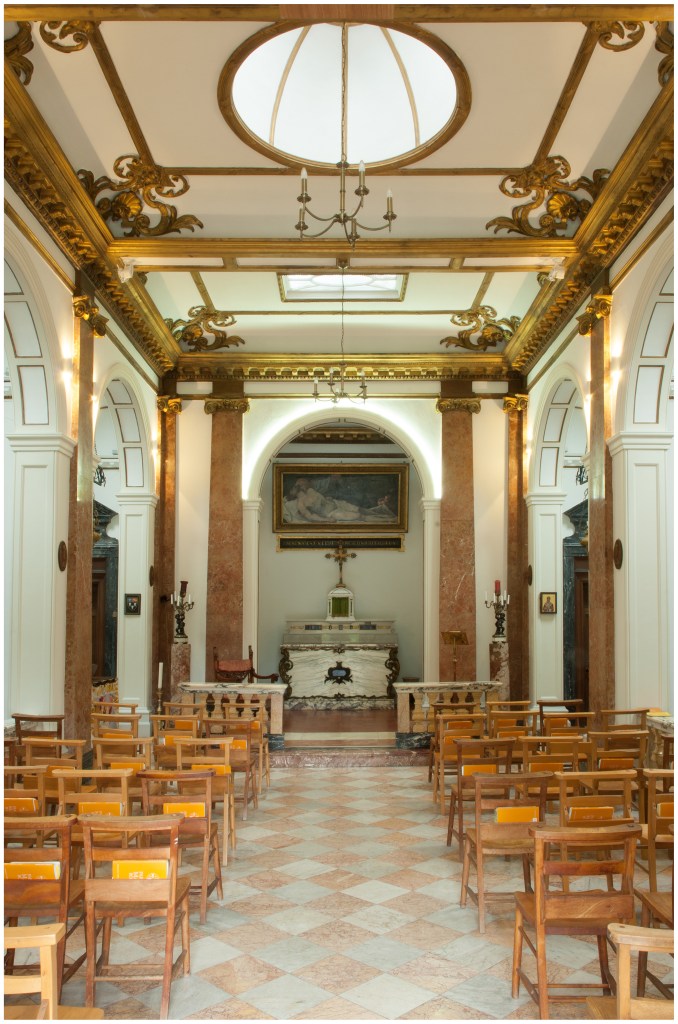Earlier this year, Philippa Martin, Keeper of Art and Decorative Art at Eton College, wrote to the V&A, requesting advice on dating an 15th–century Italian processional cross belonging to the school, which led to a visit to a little known Catholic chapel at Eton, an early 20th–century copy of a baroque church, buried in a side turning off the main High Street. The creation of this chapel was inspired by the destruction of the altar in the college chapel of St Mary’s at Eton under Edward VI 350 years earlier. In 1858 Alfred Thomas Townshend Wyatt-Edgell went to Eton College, the youngest of three brothers; aged just nine; at 17 he attended Christ Church, Oxford and was converted to Catholicism. His father was an Anglican vicar in Mayfair. After the death of his elder brothers and his mother in 1879, Alfred inherited his mother’s family estate, Stanford Hall, near Loughborough, Leicestershire. He changed his family name to Verney-Cave when he inherited the title, Lord Braye in 1880.
As an amateur architect, Alfred Verney-Cave set about restoring the property and added a private chapel, with a plain exterior surmounted by a gilded cross and an interior richly furnished with a variety of marbles, ornamental ironwork and gilded cherubs. But he did not have the means to support this and was forced to sell much of the estate and hand the house over to his eldest son, Adrian Cave. Meanwhile the private chapel succumbed to dry rot and was demolished. Lord Braye moved to Windsor in 1918.

Our Lady of Sorrows, view of the interior looking towards the main altar, with the painting of Christ taken down from the Cross now attributed to Pietra Testa above. Reproduced by permission of the Provost and Fellows of Eton College
Lord Braye had decided to build a chapel for the use of Catholic Eton boys dedicated to Our Lady of Sorrows. The building project was opposed by the College authorities who invoked an ancient law which prevented windows overlooking college land so the interior is lit through skylights. It is reminiscent of the Post-Reformation Weld family Catholic chapel at Lulworth, Dorset, the first free-standing Catholic chapel built in England, 1786, but disguised as a mausoleum, with no windows to reveal its true purpose.
The interior is lavishly decorated with fixtures and fittings from the Stanford Hall chapel and from the Royal Mausoleum Chapel, Frogmore. The elaborate main altar and side chapel altars are of various marbles mounted in ormolu designed by Braye and made in London. Side chapels are dedicated to St Joseph, St Anne (Chapel of the Relics with a reliquary on the altar and a collection of relics in gold frames on either side) and St Augustine. The chapels on the left are dedicated to St Alphonsus, the Chapel of the Blessed Sacrament and closest to the West entrance, the Chapel of our Lady; its turned marble font with neat copper lid. Either side of the main altar, chapels with pedimented doorcases lead into small sacristies. Above the sanctuary is a landscape-format painting of Christ taken down from the Cross, three foot by seven, previously attributed to Guido Reni and recently reattributed to Pietro Testa (1611–50). Either side of the altar free-standing marble column bases support putti holding torchères.

Interior of Our Lady of Sorrows, Eton College. Reproduced by permission of the Provost and Fellows of Eton College
Apparently it was only after Lord Braye’s death in 1928 and the obituary in The Times that referred to ‘his Catholic Church at Eton which the Headmaster promptly placed out of bounds’ that the Catholic boys were finally allowed to use the chapel. In 2012 the College bought the building from the Catholic Diocese of Northampton for £1. This rich interior, now sensitively preserved by the college, is maintained for the purpose for which it was dedicated by Lord Braye.
When the chapel opened on 20 January 1915, the then Headmaster Edward Littleton referred to ‘the old bitter antagonism’ between Anglicans and Catholics in the country. He wrote to Lord Braye ‘Eton cannot afford to lose her large connextion with evangelicals and others who would take umbrage at what you are going to do. To safeguard ourselves therefore I should have to make plain to everyone that as the Catholic boys are already admirably looked after here, I have flatly forbidden any boy going near the new church’. In 1915 the 20 Catholic boys and a further 21 Belgian refugees from the Great War walked the two miles each way to St Edward’s, the Catholic church on the other side of the River Thames in Windsor.














![Masterpiece [Re]discovery 2022. Photo: Ben Fisher Photography, courtesy of Masterpiece London](http://zephr.apollo-magazine.com/wp-content/uploads/2022/07/MPL2022_4263.jpg)
Suzanne Valadon’s shifting gaze